Data-Driven Analysis for Facility Management in Higher Education Institution
Abstract
:1. Introduction
2. Background and Related Studies
2.1. Planned Preventive Maintenance (PPM) and Unplanned Maintenance (UPM)
2.2. Current FM Guideline and FM Computerized Platform
- IWMS: An integrated workshop management system (IWMS) is an all-in-one way to manage your facility. It includes from real estate portfolio management to floor plan. This is the most comprehensive tool in facility management;
- CMMS: A computerized maintenance management system (CMMS) focuses solely on handling facility maintenance requests. Once the MR&R is recognized, the CMMS coordinates from ticketing requests to delegating and performing the repair activity;
- CAFM: A computer-aided facility management (CAFM) is a platform to manage the actual workplace in facility management. The system handles floor plan creation, space utilization, and MR&R. This system is more effective for space management and accommodation of workers;
- EAM: An enterprise asset management (EAM) system focuses on asset management. This system tracks the number of computers and workstations, locations of the copiers, and printers. It helps facility managers update and manage the current asset and accounting.
2.3. Facility Management Classifications
3. Methodology
3.1. Qualitative Analysis
3.2. Data Driven Analysis for Qualitative Data
3.3. Facility Management Unified Classification Database (FMUCD)
3.4. Quantitative Analysis
3.5. Data Driven Analysis for Quantitative Data: Statistical Comparison Analysis
3.6. Data Driven Analysis for Quantitative Data: Risk Profile Analysis
4. Discussion and Conclusions
Author Contributions
Funding
Data Availability Statement
Conflicts of Interest
References
- Association of Physical Plant Administrators (APPA) Facilities Maintenance and Operations. Available online: https://www.appa.org/bok/facilities-maintenance-and-operations/ (accessed on 12 September 2021).
- Amaratunga, D.; Baldry, D. Assessment of Facilities Management Performance in Higher Education Properties. Facilities 2000, 18, 293–301. [Google Scholar] [CrossRef]
- Doyen, L.; Gaudoin, O. Modeling and Assessment of Aging and Efficiency of Corrective and Planned Preventive Maintenance. IEEE Trans. Reliab. 2011, 60, 759–769. [Google Scholar] [CrossRef]
- Rani, N.A.A.; Baharum, M.R.; Akbar, A.R.N.; Nawawi, A.H. Perception of Maintenance Management Strategy on Healthcare Facilities. Procedia-Soc. Behav. Sci. 2015, 170, 272–281. [Google Scholar] [CrossRef] [Green Version]
- Yoon, S.J. New Paradigm for Deferred Maintenance Budget Allocation 2018; Purdue University: West Lafayette, IN, USA, 2018. [Google Scholar]
- Rose, R. Buildings—The Gifts That Keep on Taking: A Framework for Integrated Decision Making; APPA CFaR Center for Facilities Research; APPA: Alexandria, VA, USA, 2007; ISBN 1890956384. [Google Scholar]
- Yoon, S.; Weidner, T.; Hastak, M. Total-Package-Prioritization Mitigation Strategy for Deferred Maintenance of a Campus-Sized Institution. J. Constr. Eng. Manag. 2021, 147, 4020185. [Google Scholar] [CrossRef]
- Wright, T.S.A.; Wilton, H. Facilities Management Directors’ Conceptualizations of Sustainability in Higher Education. J. Clean. Prod. 2012, 31, 118–125. [Google Scholar] [CrossRef]
- Lavy, S. Facility Management Practices in Higher Education Buildings. J. Facil. Manag. 2008, 6, 303–315. [Google Scholar] [CrossRef]
- Oseghale, G.E.; Ikpo, I.J. An Evaluation of Industrial Facilities Defects in Selected Industrial Estates in Lagos State, Nigeria. Civ. Eng. Dimens. 2014, 16, 171–179. [Google Scholar] [CrossRef] [Green Version]
- Che-Ani, A.I.; Ali, R. Facility Management Demand Theory. J. Facil. Manag. 2019, 17, 344–355. [Google Scholar] [CrossRef]
- Fregonese, L.; Achille, C.; Adami, A.; Fassi, F.; Spezzoni, A.; Taffurelli, L. BIM: An Integrated Model for Planned and Preventive Maintenance of Architectural Heritage. In Proceedings of the 2015 Digital Heritage, Granada, Spain, 28 September–2 October 2015; Volume 2, pp. 77–80. [Google Scholar]
- Trojan, F.; Marçal, R.F.M. Proposal of Maintenance-Types Classification to Clarify Maintenance Concepts in Production and Operations Management. J. Bus. Econ. 2017, 8, 560–572. [Google Scholar]
- Stenström, C.; Norrbin, P.; Parida, A.; Kumar, U. Preventive and Corrective Maintenance-Cost Comparison and Cost-Benefit Analysis. Struct. Infrastruct. Eng. 2016, 12, 603–617. [Google Scholar] [CrossRef]
- Wang, Y.; Deng, C.; Wu, J.; Wang, Y.; Xiong, Y. A Corrective Maintenance Scheme for Engineering Equipment. Eng. Fail. Anal. 2014, 36, 269–283. [Google Scholar] [CrossRef]
- Weidner, T.; Adams, M. Maintenance Staffing Guidelines for Educational Facilities; APPA: Alexandria, VA, USA, 2002; ISBN 1-890956-23-6. [Google Scholar]
- Bigger, A.S.; Becker, J.T. Operational Guidelines for Educational Facilities-Maintenance, 2nd ed.; APPA: Alexandria, VA, USA, 2011; Volume 2, ISBN 1-890956-67-8. [Google Scholar]
- Szuba, T. Planning Guide for Maintaining School Facilities; DIANE Publishing: Darby, PA, USA, 2003; ISBN 1428925597. [Google Scholar]
- Whitestone Research. The Whitestone Facility Maintenance and Repair Cost Reference, 18th ed.; Whitestone Research: Santa Barbara, CA, USA, 2014. [Google Scholar]
- Sheynkman, A. What’s the Difference: IWMS, CMMS, CAFM and EAM? Available online: https://spaceiq.com/blog/difference-between-iwms-cmms-cafm-eam/ (accessed on 27 July 2021).
- Afsari, K.; Eastman, C.M. A Comparison of Construction Classification Systems Used for Classifying Building Product Models. In Proceedings of the 52nd ASC Annual International Conference Proceedings, Provo, UT, USA, 13–16 April 2016; pp. 1–8. [Google Scholar]
- Kula, B.; Ergen, E.; Kula, B.; Ergen, E. Review of Classification Systems for Facilities Management. In Proceedings of the 13th International Congress on Advances in Civil Engineering, Izmir, Turkey, 12–14 September 2018; pp. 1–8. [Google Scholar]
- Charette, R.P.; Marshall, H.E. UNIFORMAT II Elemental Classification for Building Specifications, Cost Estimating, and Cost Analysis; Department of Commerce, Technology Administration, National Institute of Standards and Technology: USA, 1999; ISBN NISTIR 6389.
- MasterFormat®. Available online: https://www.csiresources.org/standards/masterformat (accessed on 21 July 2021).
- UniFormatTM: A Uniform Classification of Construction Systems and Assemblies; The Construction Specifications Institute: Alexandria, VA, USA, 2010; ISBN 978-0-9845357-1-2.
- OmniClassTM. Available online: https://www.csiresources.org/standards/omniclass (accessed on 21 July 2021).
- Gelder, J. The Principles of a Classification System for BIM: Uniclass 2015. In Proceedings of the 49th International Conference of the Architectural Science Association, Melbourne, VIC, Australia, 2–4 December 2015; Volume 1, pp. 287–297. [Google Scholar]
- UNSPSC. Available online: https://www.unspsc.org/ (accessed on 21 July 2021).
- Leh, A.; Köhler, J.; Gref, M.; Himmelmann, N.P. Speech Analytics in Research Based on Qualitative Interviews. VIEW J. Eur. Telev. Hist. Cult. 2018, 7, 138. [Google Scholar] [CrossRef]
- Valenti, A.P.; Chita-Tegmark, M.; Tickle-Degnen, L.; Bock, A.W.; Scheutz, M.J. Using Topic Modeling to Infer the Emotional State of People Living with Parkinson’s Disease. Assist. Technol. 2021, 33, 136–145. [Google Scholar] [CrossRef] [PubMed]
- Parmar, M.; Maturi, B.; Dutt, J.M.; Phate, H. Sentiment Analysis on Interview Transcripts: An Application of NLP for Quantitative Analysis. In Proceedings of the 2018 International Conference on Advances in Computing, Communications and Informatics (ICACCI), Bangalore, India, 19–22 September 2018; pp. 1063–1068. [Google Scholar]
- Hagen, L.; Uzuner, O.; Kotfila, C.; Harrison, T.M.; Lamanna, D. Understanding Citizens’ Direct Policy Suggestions to the Federal Government: A Natural Language Processing and Topic Modeling Approach. In Proceedings of the 2015 48th Hawaii International Conference on System Sciences, Kauai, HI, USA, 5–8 January 2015; Volume 2015, pp. 2134–2143. [Google Scholar]
- Lee, T.Y.; Smith, A.; Seppi, K.; Elmqvist, N.; Boyd-Graber, J.; Findlater, L. The Human Touch: How Non-Expert Users Perceive, Interpret, and Fix Topic Models. Int. J. Hum. Comput. Stud. 2017, 105, 28–42. [Google Scholar] [CrossRef] [Green Version]
- Archibus Inc. Available online: https://archibus.com/about/ (accessed on 10 August 2021).
- Hutto, C.; Gilbert, E. Vader: A Parsimonious Rule-Based Model for Sentiment Analysis of Social Media Text. In Proceedings of the International AAAI Conference on Web and Social Media, Ann Arbor, MI, USA, 1–4 July 2014; Volume 8, pp. 216–225. [Google Scholar]
- Chatterjee, A.; Perrizo, W. Sentiment Trends and Classifying Stocks Using P-Trees. In From Social Data Mining and Analysis to Prediction and Community Detection; Springer: Berlin/Heidelberg, Germany, 2017; pp. 103–121. [Google Scholar]
- Chatterjee, A.; Perrizo, W. Investor Classification and Sentiment Analysis. In Proceedings of the 2016 IEEE/ACM International Conference on Advances in Social Networks Analysis and Mining (ASONAM), San Francisco, CA, USA, 18–21 August 2016; pp. 1177–1180. [Google Scholar]
- Maiti, J.; Khanzode, V.V.; Ray, P.K. Severity Analysis of Indian Coal Mine Accidents—A Retrospective Study for 100 Years. Saf. Sci. 2009, 47, 1033–1042. [Google Scholar] [CrossRef]
- Chiew, E.; Cauthen, K.; Brown, N.; Nozick, L. Comparison of Distribution Selection Methods. Commun. Stat.-Simul. Comput. 2022, 51, 1982–2005. [Google Scholar] [CrossRef]
- Washington, S.; Karlaftis, M.; Mannering, F.; Anastasopoulos, P. Statistical and Econometric Methods for Transportation Data Analysis; Chapman and Hall: London, UK; CRC: Boca Raton, FL, USA, 2020; ISBN 0429244010. [Google Scholar]
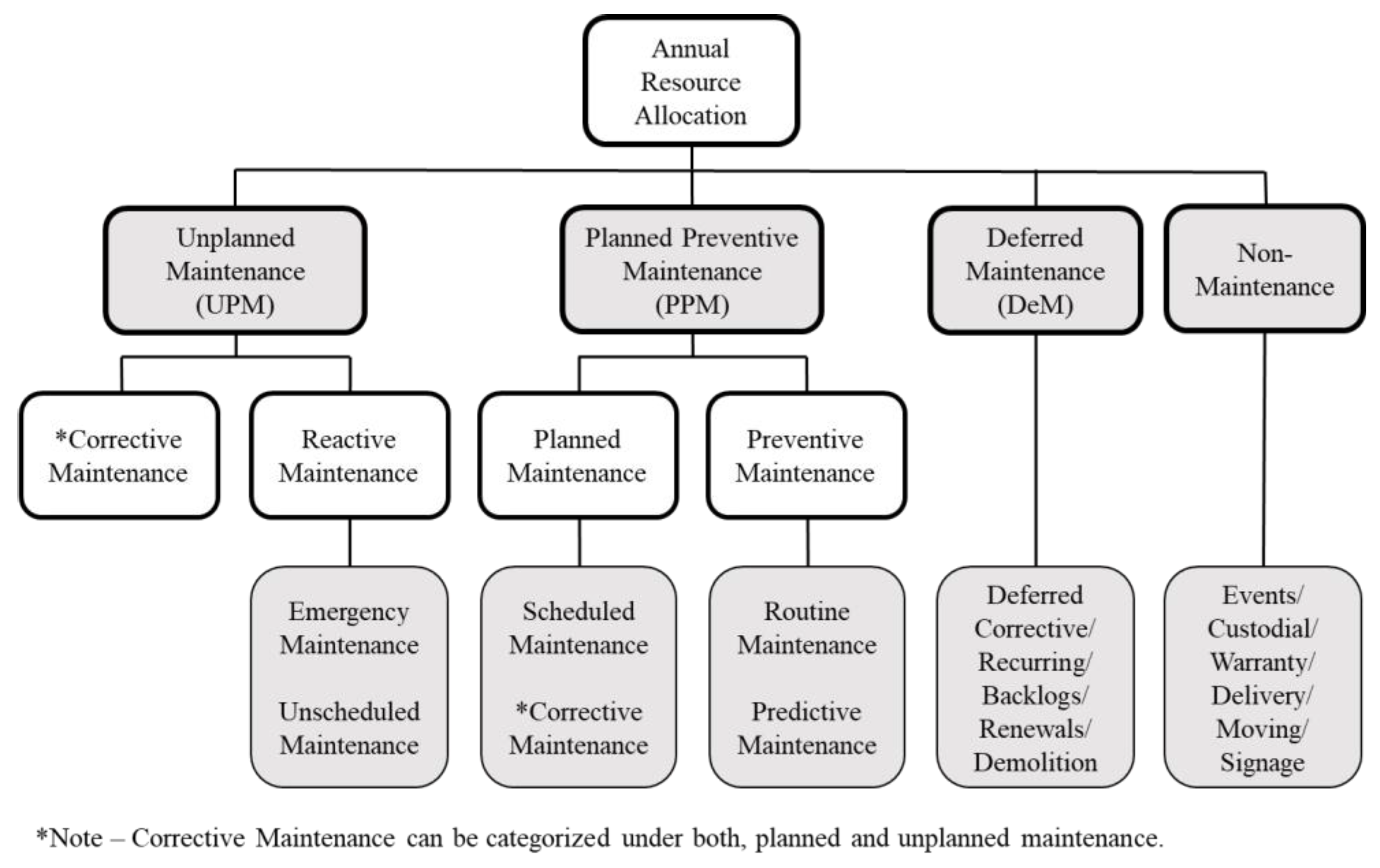


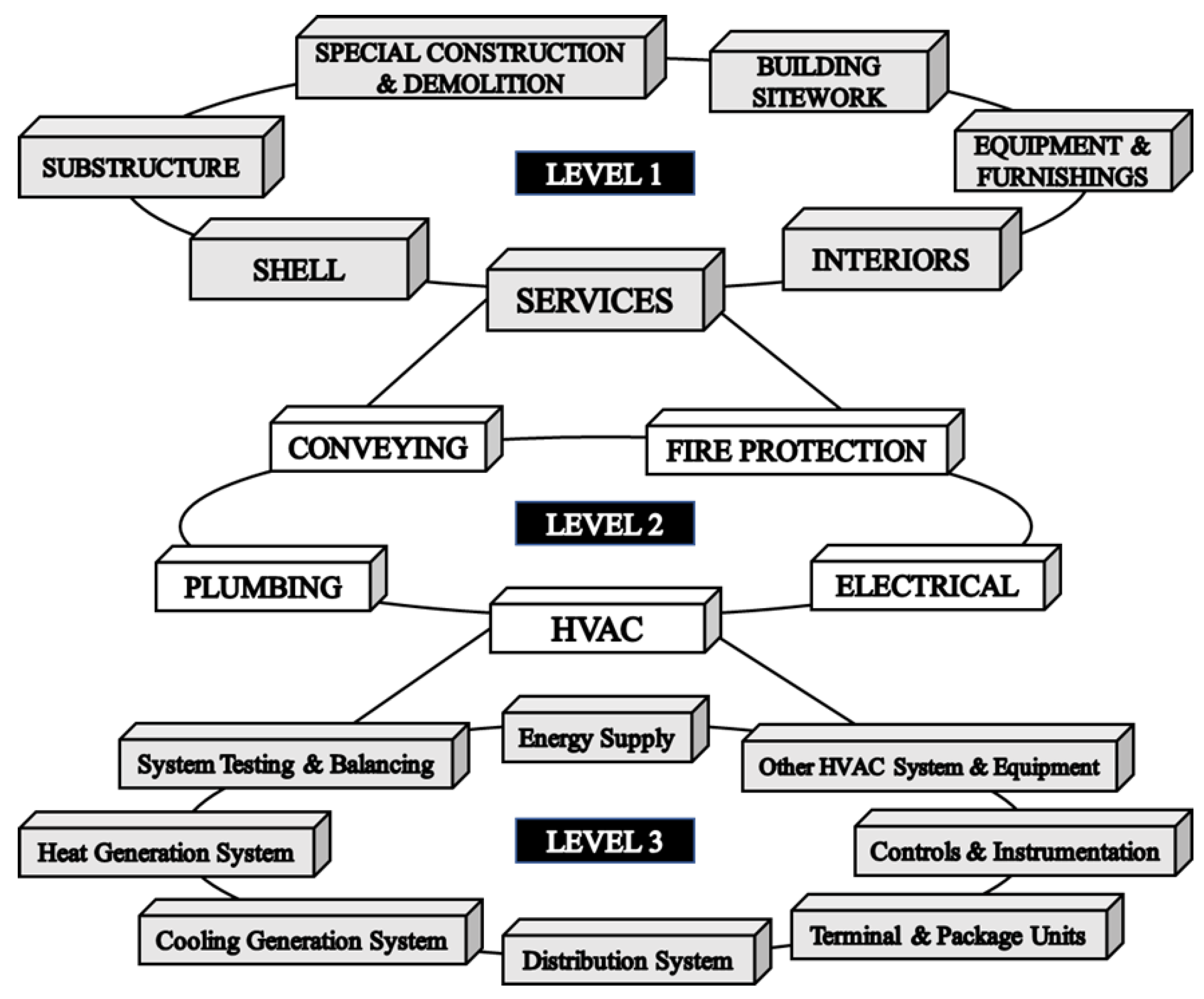


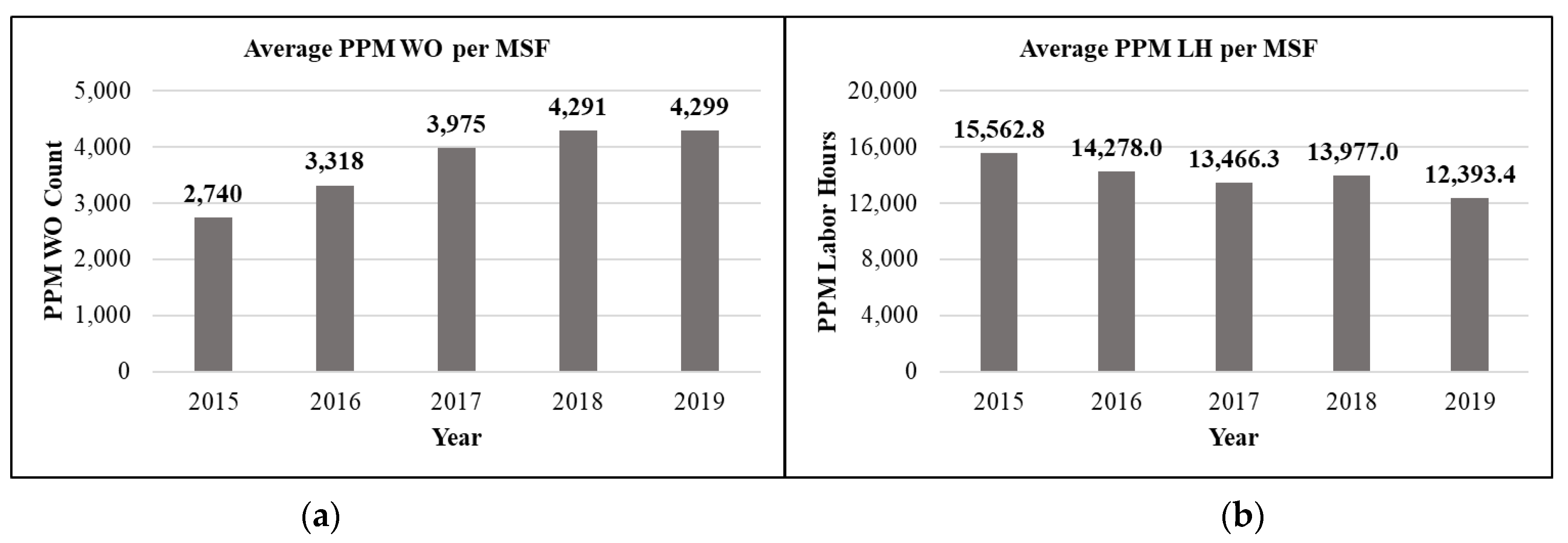

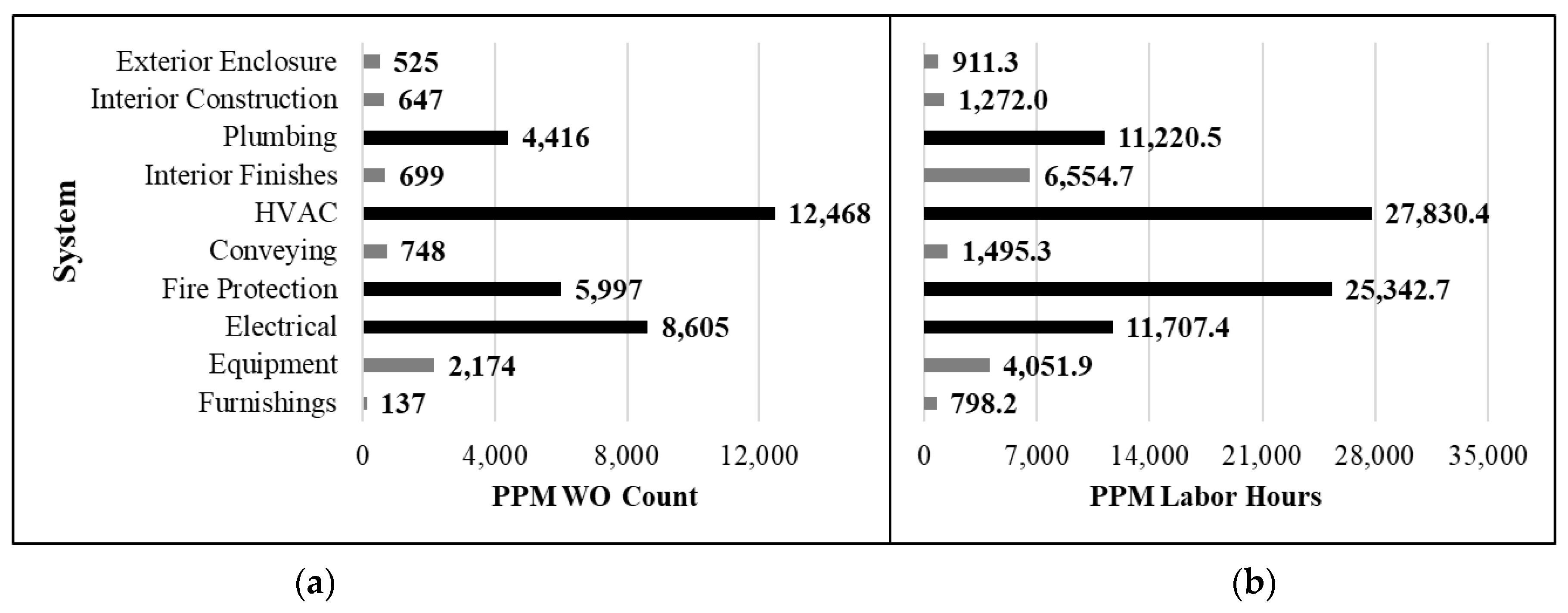
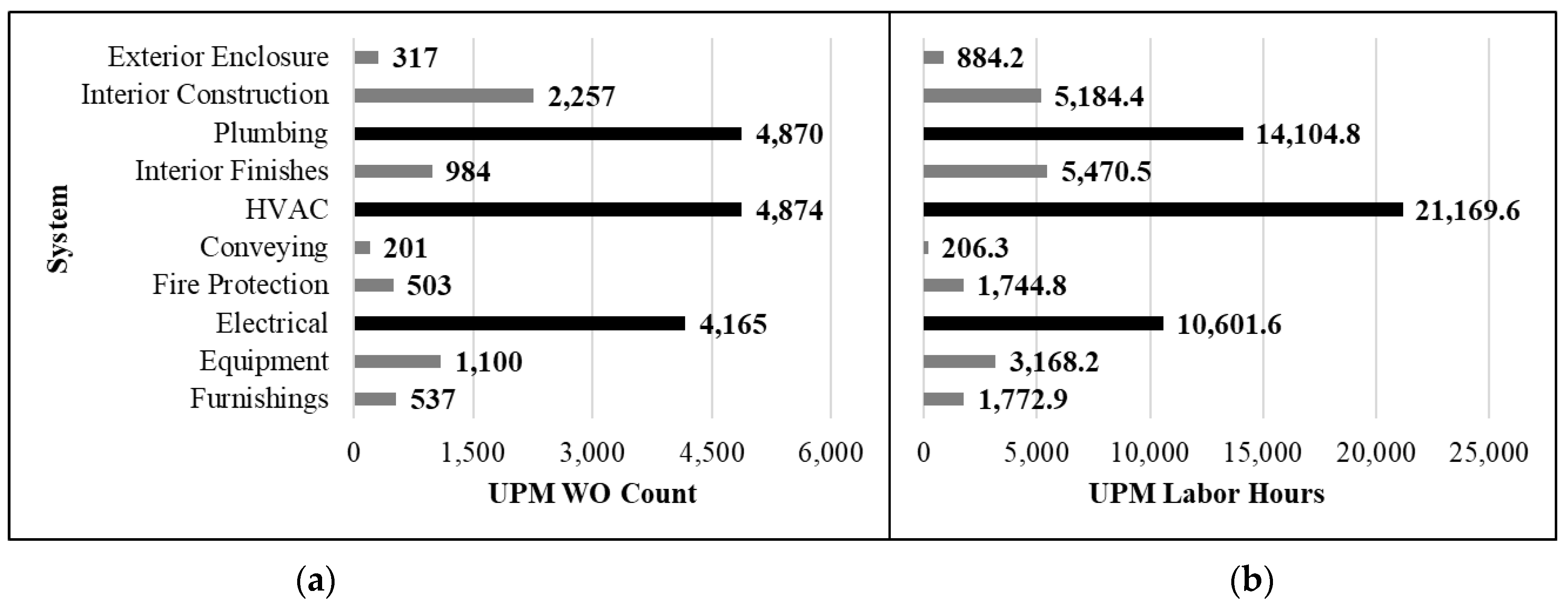
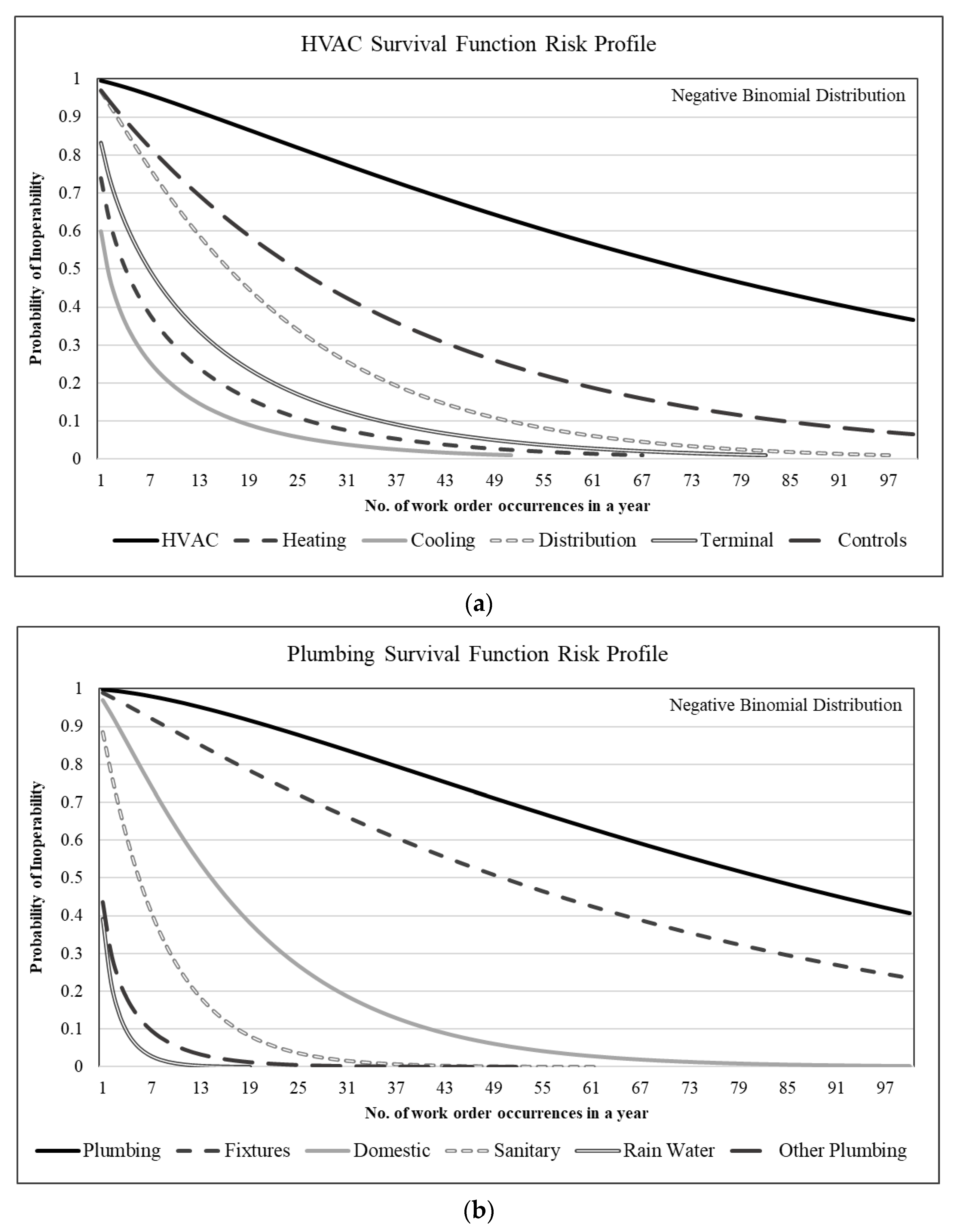

| No | Classification System | Origin | Updated Year | Classification Structure | Levels | Elements Grouping | Component (Detailed/Neutral/Less Details/Not Detailed) |
|---|---|---|---|---|---|---|---|
| 1 | Uniformat II | North America | 1999 | Hierarchical | 3 | Functional | Not Detailed |
| 2 | MasterFormat® | North America | 2020 | Hierarchical | 4 | Mounted Elements | Less Detailed |
| 3 | UniformatTM | North America | 2010 | Hierarchical | 5 | Functional | Neutral |
| 4 | OmniClassTM | North America | 2015 | Faceted | 6 | Functional | Less Detailed |
| 5 | Uniclass | United Kingdom | 2015 | Faceted | 4 to 5 | Functional | Less Detailed |
| 6 | UNSPSC | North America | 2017 | Hierarchical | 5 | Mounted Elements | Not Detailed |
| No | Question | Answers | Responses | |
|---|---|---|---|---|
| n | % | |||
| 1 | How do you evaluate progress of the PPM work assignments? | Reports generated by CMMS | 24 | 50% |
| Key Performance Indicator—KPI | 15 | 31% | ||
| Paper reports | 7 | 15% | ||
| Other | 2 | 4% | ||
| 2 | Where are PPM work orders prioritized among all work order types? | Above scheduled corrective | 12 | 43% |
| Dedicated crew for PPM work | 8 | 29% | ||
| Lowest priority | 7 | 25% | ||
| Above critical | 1 | 3% | ||
| 3 | What is included in the PPM work order estimates? | Work | 26 | 25% |
| Set-up | 21 | 20% | ||
| Clean-up | 20 | 19% | ||
| Documentation | 15 | 14% | ||
| Travel (before the PPM) | 13 | 12% | ||
| Travel (after the PPM) | 8 | 8% | ||
| Others | 3 | 3% | ||
| 4 | How do you estimate PPM worker time? | Prior experience | 17 | 28% |
| Multiple factors (e.g., guide, prior records) | 16 | 26% | ||
| Prior time records | 13 | 21% | ||
| Estimating guide (RS Means, Dodge, other) | 9 | 15% | ||
| Manufacturer recommendations | 6 | 10% | ||
| 5 | Prioritize how you would improve PPM effectiveness | Prioritization strategy | 19 | 76% |
| Additional funding | 4 | 16% | ||
| Additional staff | 2 | 8% | ||
| No | Question | Answers | Responses (N = 12) | |
|---|---|---|---|---|
| n | % | |||
| 1 | Do you have an organized maintenance plan? | Schedule maintenance | 5 | 42% |
| PPM | 5 | 41% | ||
| System/Subsystem | 2 | 17% | ||
| 2 | How do you classify the building systems and components? | Uniformat | 5 | 42% |
| MasterFormat | 4 | 33% | ||
| OmniClass | 2 | 17% | ||
| Other | 1 | 8% | ||
| 3 | Is each maintenance task performed on an individual component tracked? | Yes | 7 | 58% |
| No | 5 | 42% | ||
| 4 | When do you record work order information? | End of activity | 7 | 58% |
| End of shift | 5 | 42% | ||
| Mid-shift | 0 | 0% | ||
| 5 | Who records work order? | Craft/Technician | 10 | 83% |
| Supervisor | 2 | 17% | ||
| Office clerk | 0 | 0% | ||
| 6 | Where is the data recorded? | Electronically/CMMS | 9 | 75% |
| Both | 2 | 17% | ||
| Manually/Papers | 1 | 8% | ||
| No | Topic | Keywords |
|---|---|---|
| 1 | PPM | Maintenance, plan, work, preventive, evaluate, worker, frequency, critical, year, order, asset, schedule, fix |
| 2 | Maintenance system | PMS, system, work, zone, order, equipment, time, Archibus, record, manager, worker |
| System | Subsystem | Data Range | Poisson AIC | Poisson BIC | Negative Binomial AIC | Negative Binomial BIC | No. of Successes (r) | Event Prob. (p) |
|---|---|---|---|---|---|---|---|---|
| HVAC | Total HVAC | 1 to 1023 | 51,684.54 | 51,689.29 | 9325.54 | 9335.03 | 1.2583 | 0.0130 |
| Heating | 0 to 184 | 13,351.13 | 13,355.87 | 5510.13 | 5519.62 | 0.4350 | 0.0453 | |
| Cooling | 0 to 118 | 11,943.97 | 11,948.72 | 4509.96 | 4519.45 | 0.3058 | 0.0505 | |
| Distributions | 0 to 153 | 17,653.43 | 17,658.18 | 6981.43 | 6990.92 | 1.1479 | 0.0489 | |
| Terminal Units | 0 to 200 | 16,133.57 | 16,138.31 | 6121.44 | 6130.93 | 0.5614 | 0.0414 | |
| Controls | 0 to 440 | 26,742.70 | 26,747.44 | 7761.73 | 7771.22 | 0.9742 | 0.0264 | |
| Plumbing | Total Plumbing | 0 to 566 | 47,664.31 | 47,669.06 | 9334.98 | 9344.47 | 1.6313 | 0.0157 |
| Fixtures | 0 to 497 | 43,823.68 | 43,828.42 | 8801.60 | 8811.09 | 1.1198 | 0.0160 | |
| Domestic | 0 to 129 | 14,114.42 | 14,119.17 | 6627.55 | 6637.04 | 1.2877 | 0.0652 | |
| Sanitary | 0 to 62 | 8295.90 | 8300.64 | 5164.35 | 5173.84 | 1.0520 | 0.1273 | |
| Rainwater | 0 to 19 | 3023.30 | 3028.05 | 2351.56 | 2361.05 | 0.3733 | 0.2628 | |
| Other Plumbing | 0 to 52 | 5490.91 | 5495.66 | 2945.88 | 2955.37 | 0.2667 | 0.1169 | |
| Electrical | Total Electrical | 1 to 541 | 54,697.38 | 54,702.13 | 9205.89 | 9215.38 | 1.1549 | 0.0132 |
| Service | 0 to 81 | 8876.86 | 8881.61 | 4844.37 | 4853.86 | 0.6360 | 0.0967 | |
| Lighting | 1 to 393 | 43,445.45 | 43,450.20 | 8577.99 | 8587.48 | 0.9948 | 0.0169 | |
| Communications | 0 to 141 | 15,373.17 | 15,377.91 | 6454.95 | 6464.44 | 0.9544 | 0.0567 | |
| Other Electrical | 0 to 208 | 10,382.39 | 10,387.14 | 2933.79 | 2943.28 | 0.0483 | 0.0177 |
| No | Top Component | No. of Occurrence | System | Subsystem | Descriptive Code |
|---|---|---|---|---|---|
| 1. | Thermostat | 390 | HVAC | Controls & Instrumentation | D3060THE |
| 2. | Fluorescent Light Fixture | 345 | Electrical | Lighting & Branch Wirings | D5020FLF |
| 3. | Sink | 232 | Plumbing | Plumbing Fixtures | D2010SNK |
| 4. | Battery | 207 | Electrical | Other Electrical Systems | D5090BAT |
| 5. | Toilet & Wash Basin | 180 | Plumbing | Plumbing Fixtures | D2010TWB |
| 6. | Air Conditioner | 136 | HVAC | Terminal & Package Units | D3050ACO |
| 7. | Air Handler | 127 | HVAC | Distribution Systems | D3040AHD |
| 8. | HVAC Control Panel | 127 | HVAC | Controls & Instrumentation | D3060HVA |
| 9. | Bathtub & Shower Enclosure | 116 | Plumbing | Plumbing Fixtures | D2010BSE |
| 10. | Radiator | 103 | HVAC | Heat Generation Systems | D3020RFW |
Publisher’s Note: MDPI stays neutral with regard to jurisdictional claims in published maps and institutional affiliations. |
© 2022 by the authors. Licensee MDPI, Basel, Switzerland. This article is an open access article distributed under the terms and conditions of the Creative Commons Attribution (CC BY) license (https://creativecommons.org/licenses/by/4.0/).
Share and Cite
Pampana, A.K.; Jeon, J.; Yoon, S.; Weidner, T.J.; Hastak, M. Data-Driven Analysis for Facility Management in Higher Education Institution. Buildings 2022, 12, 2094. https://doi.org/10.3390/buildings12122094
Pampana AK, Jeon J, Yoon S, Weidner TJ, Hastak M. Data-Driven Analysis for Facility Management in Higher Education Institution. Buildings. 2022; 12(12):2094. https://doi.org/10.3390/buildings12122094
Chicago/Turabian StylePampana, Ashish Kumar, JungHo Jeon, Soojin Yoon, Theodore J. Weidner, and Makarand Hastak. 2022. "Data-Driven Analysis for Facility Management in Higher Education Institution" Buildings 12, no. 12: 2094. https://doi.org/10.3390/buildings12122094







